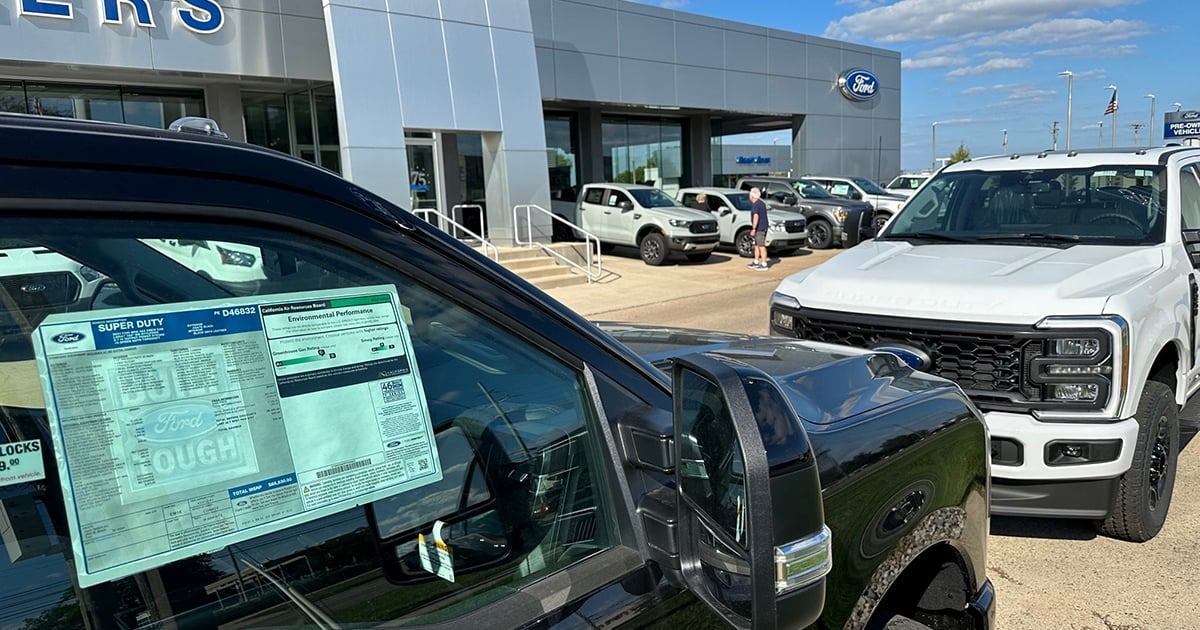
Extreme weather in Southern California and Florida and a holdout for Labor Day deals contributed to a softer-than-expected U.S. new-vehicle market in August.
Business was up around the industry, with auto sales totaling 1.33 million vehicles for the month, a 17 percent increase over August 2022, according to a preliminary report by Global Data. For the seven automakers that report monthly U.S. sales, volume increased 12.5 percent over the year-ago month, according to Automotive News Research & Data Center.
The results track with volumes reported by the industry over the past six months, but signs indicate the market could be contracting.
The seasonally adjusted annual rate of sales for August was 15.17 million, according to Motor Intelligence. That figure came in below forecasts and down from July’s 15.9 million pace, but far above the August 2022 SAAR of 13.4 million.
Year-over-year growth will start to appear weaker moving closer to December because last August is when inventory started to recover following the post-pandemic disruptions, Charlie Chesbrough, Cox Automotive senior analyst, told Automotive News.
“We are expecting a slowdown with higher interest rates, less credit availability and pent-up demand from the pandemic that already has been satisfied,” Chesbrough said, noting that industry sales will not get back to 17 million levels anytime soon.
Though SAAR remained over the 15 million mark, the baseline each month this year, Global Data adjusted its 2023 forecast downward to 15.3 million units from 15.4 million. The firm said the real possibility of a UAW strike and its potential impact on inventory stockpiles was a factor.
Fleet sales outpaced the retail market and supported much of the growth in August. The fleet market share was estimated to be 15.6 percent — an increase of 2.2 percent over last year’s share but a decrease from 16 percent in July — as automakers relied on more plentiful inventories to fill backlogs to fleet clients.
J.D. Power and GlobalData said retail inventory levels in August had risen to about 1.3 million vehicles, an increase from July and up 48 percent compared with August 2022. The figure was still well below pre-pandemic levels, however.
Macro headwinds, such as elevated transaction prices and high interest rates, continue to sideline price-conscious buyers, but more choices at dealerships and a return to incentives are nudging the market along.
Toyota Motor Corp., Ford Motor Co., Honda, Hyundai, Kia, Subaru and Mazda all continued to rebound thanks to more plentiful inventory and increasing incentives to offset rising interest rates.
Toyota Motor, which includes the Toyota and Lexus brands, reported a sales increase of 15 percent. Toyota and Lexus sales were up 16 percent and 9.4 percent, respectively. Toyota said strong sales were driven mostly by a 21 percent increase in light-truck sales.
Toyota Motor said it ended August with 174,567 light vehicles in U.S. stock, or a 24-day supply. The Toyota brand had 142,257 vehicles in stock, or a 23-day supply, to start September while Lexus has a stockpile of 32,320 cars and light trucks, or a 37-day supply.
Ford Motor August sales rose 2 percent, thanks to a 10 percent increase in pickup deliveries. Volume at Ford Division rose 2 percent and Lincoln sales increased 3.1 percent. Ford brand sales have climbed nine consecutive months, while August is the fourth month this year that Lincoln has logged an increase, though not consecutively.
Ford said it ended August with U.S. gross vehicle stocks of 383,300, up from 359,100 at the start of the month.
Honda Motor, which struggled to recover following the chip shortage, continues to see rebounding sales even as it works through “industry logistics and supply issues.” In August, combined Honda and Acura volume surged 57 percent; Honda brand sales increased 56 percent and Acura saw a rise of 61 percent.
Honda ended August with 31,900 new vehicles on the ground, down from 32,000 to start the month, but up from 13,700 heading into September 2022. Acura finished August with about 17,678 vehicles on the ground, slightly up from 17,400 at the start of the month and a sharp increase from 3,089 heading into September 2022.
Hyundai and Kia continue to enjoy growth. Hyundai Motor America sales increased 1.1 percent to 65,046, while Kia America reported a gain of 9.2 percent to 72,147.
The automakers — which operate separately despite sharing the same parent, Hyundai Motor Group — have been neck and neck all year. Kia sales surpassed Hyundai’s in August, as it did in February, May, June and July.
Kia America Vice President of Sales Operations Eric Watson attributed its success, exceeding sales of 70,000 vehicles for four consecutive months, to its “highly desirable and innovative models across many of the industry’s largest segments.”
Genesis, Hyundai’s luxury brand, logged an increase of 27 percent.
August inventory for Hyundai was 53,075 vehicles, up from 47,836 in July. Inventory in August 2022 was 19,209.
Subaru posted its 13th consecutive monthly sales gain with August volume up 13 percent to 56,407 behind stronger deliveries of the Forester, Legacy and Outback.
Mazda’s August sales advanced 19 percent to 30,174 — its 11th straight monthly gain. Mazda car sales rose 17 percent and light-truck volume rose 19 percent. Volvo said August sales rose 31 percent.
The average new-vehicle retail transaction price in August is expected to reach $45,537, down $566 from August 2022. The previous high for any month — $47,362 — was set in December.
Average transaction prices have come down from their peak, Chesbrough said, but whether they will continue to drop is the big question.
“They will likely elevate again come December when many luxury buyers enter the market looking for sales like Lexus’ notable ‘December to Remember,’ ” he said.
Average incentive spending per vehicle in August is expected to reach $1,902, up from $953 in August 2022.
Spending as a percentage of the average sticker price is expected to increase to 4 percent, up 1.9 percentage points from August 2022, according to J.D. Power.

